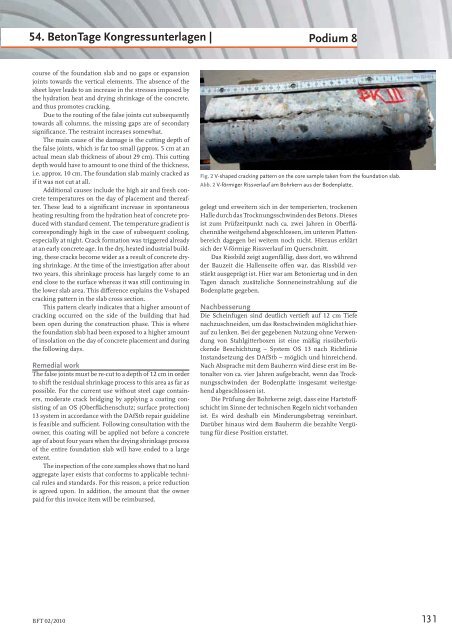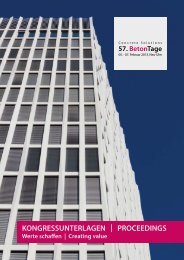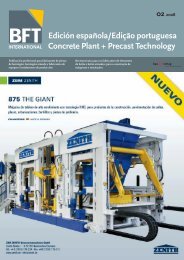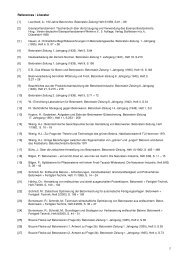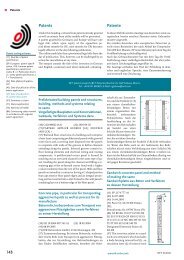Concrete Plant + Precast Technology Betonwerk ... - BFT International
Concrete Plant + Precast Technology Betonwerk ... - BFT International
Concrete Plant + Precast Technology Betonwerk ... - BFT International
Sie wollen auch ein ePaper? Erhöhen Sie die Reichweite Ihrer Titel.
YUMPU macht aus Druck-PDFs automatisch weboptimierte ePaper, die Google liebt.
54. BetonTage Kongressunterlagen |<br />
course of the foundation slab and no gaps or expansion<br />
joints towards the vertical elements. The absence of the<br />
sheet layer leads to an increase in the stresses imposed by<br />
the hydration heat and drying shrinkage of the concrete,<br />
and thus promotes cracking.<br />
Due to the routing of the false joints cut subsequently<br />
towards all columns, the missing gaps are of secondary<br />
signifi cance. The restraint increases somewhat.<br />
The main cause of the damage is the cutting depth of<br />
the false joints, which is far too small (approx. 5 cm at an<br />
actual mean slab thickness of about 29 cm). This cutting<br />
depth would have to amount to one third of the thickness,<br />
i.e. approx. 10 cm. The foundation slab mainly cracked as<br />
if it was not cut at all.<br />
Additional causes include the high air and fresh concrete<br />
temperatures on the day of placement and thereafter.<br />
These lead to a signifi cant increase in spontaneous<br />
heating resulting from the hydration heat of concrete produced<br />
with standard cement. The temperature gradient is<br />
correspondingly high in the case of subsequent cooling,<br />
especially at night. Crack formation was triggered already<br />
at an early concrete age. In the dry, heated industrial building,<br />
these cracks become wider as a result of concrete drying<br />
shrinkage. At the time of the investigation after about<br />
two years, this shrinkage process has largely come to an<br />
end close to the surface whereas it was still continuing in<br />
the lower slab area. This diff erence explains the V-shaped<br />
cracking pattern in the slab cross section.<br />
This pattern clearly indicates that a higher amount of<br />
cracking occurred on the side of the building that had<br />
been open during the construction phase. This is where<br />
the foundation slab had been exposed to a higher amount<br />
of insolation on the day of concrete placement and during<br />
the following days.<br />
Remedial work<br />
The false joints must be re-cut to a depth of 12 cm in order<br />
to shift the residual shrinkage process to this area as far as<br />
possible. For the current use without steel cage containers,<br />
moderate crack bridging by applying a coating consisting<br />
of an OS (Oberfl ächenschutz; surface protection)<br />
13 system in accordance with the DAfStb repair guideline<br />
is feasible and suffi cient. Following consultation with the<br />
owner, this coating will be applied not before a concrete<br />
age of about four years when the drying shrinkage process<br />
of the entire foundation slab will have ended to a large<br />
extent.<br />
The inspection of the core samples shows that no hard<br />
aggregate layer exists that conforms to applicable technical<br />
rules and standards. For this reason, a price reduction<br />
is agreed upon. In addition, the amount that the owner<br />
paid for this invoice item will be reimbursed.<br />
<strong>BFT</strong> 02/2010<br />
Podium 8<br />
Fig. 2 V-shaped cracking pattern on the core sample taken from the foundation slab.<br />
Abb. 2 V-förmiger Rissverlauf am Bohrkern aus der Bodenplatte.<br />
gelegt und erweitern sich in der temperierten, trockenen<br />
Halle durch das Trocknungsschwinden des Betons. Dieses<br />
ist zum Prüfzeitpunkt nach ca. zwei Jahren in Oberfl ächennähe<br />
weitgehend abgeschlossen, im unteren Plattenbereich<br />
dagegen bei weitem noch nicht. Hieraus erklärt<br />
sich der V-förmige Rissverlauf im Querschnitt.<br />
Das Rissbild zeigt augenfällig, dass dort, wo während<br />
der Bauzeit die Hallenseite off en war, das Rissbild verstärkt<br />
ausgeprägt ist. Hier war am Betoniertag und in den<br />
Tagen danach zusätzliche Sonneneinstrahlung auf die<br />
Bodenplatte gegeben.<br />
Nachbesserung<br />
Die Scheinfugen sind deutlich vertieft auf 12 cm Tiefe<br />
nachzuschneiden, um das Restschwinden möglichst hierauf<br />
zu lenken. Bei der gegebenen Nutzung ohne Verwendung<br />
von Stahlgitterboxen ist eine mäßig rissüberbrückende<br />
Beschichtung – System OS 13 nach Richtlinie<br />
Instandsetzung des DAfStb – möglich und hinreichend.<br />
Nach Absprache mit dem Bauherrn wird diese erst im Betonalter<br />
von ca. vier Jahren aufgebracht, wenn das Trocknungsschwinden<br />
der Bodenplatte insgesamt weitestgehend<br />
abgeschlossen ist.<br />
Die Prüfung der Bohrkerne zeigt, dass eine Hartstoff -<br />
schicht im Sinne der technischen Regeln nicht vorhanden<br />
ist. Es wird deshalb ein Minderungsbetrag vereinbart.<br />
Darüber hinaus wird dem Bauherrn die bezahlte Vergütung<br />
für diese Position erstattet.<br />
131


